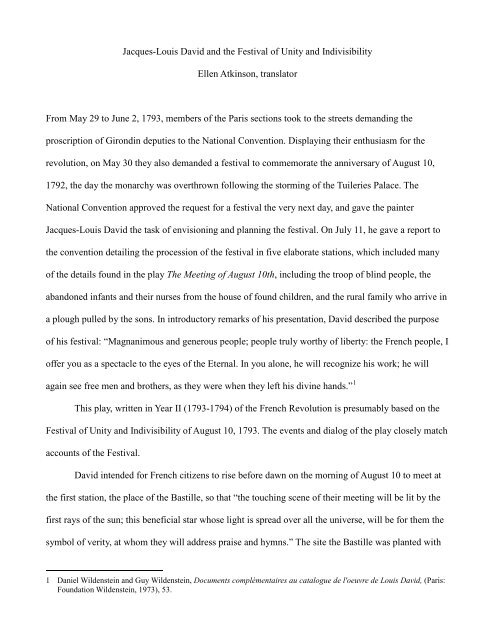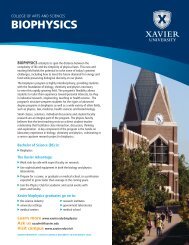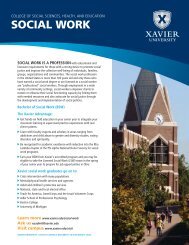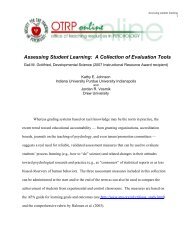Jacques-Louis David and the Festival of Unity ... - Xavier University
Jacques-Louis David and the Festival of Unity ... - Xavier University
Jacques-Louis David and the Festival of Unity ... - Xavier University
Create successful ePaper yourself
Turn your PDF publications into a flip-book with our unique Google optimized e-Paper software.
<strong>Jacques</strong>-<strong>Louis</strong> <strong>David</strong> <strong>and</strong> <strong>the</strong> <strong>Festival</strong> <strong>of</strong> <strong>Unity</strong> <strong>and</strong> Indivisibility<br />
Ellen Atkinson, translator<br />
From May 29 to June 2, 1793, members <strong>of</strong> <strong>the</strong> Paris sections took to <strong>the</strong> streets dem<strong>and</strong>ing <strong>the</strong><br />
proscription <strong>of</strong> Girondin deputies to <strong>the</strong> National Convention. Displaying <strong>the</strong>ir enthusiasm for <strong>the</strong><br />
revolution, on May 30 <strong>the</strong>y also dem<strong>and</strong>ed a festival to commemorate <strong>the</strong> anniversary <strong>of</strong> August 10,<br />
1792, <strong>the</strong> day <strong>the</strong> monarchy was overthrown following <strong>the</strong> storming <strong>of</strong> <strong>the</strong> Tuileries Palace. The<br />
National Convention approved <strong>the</strong> request for a festival <strong>the</strong> very next day, <strong>and</strong> gave <strong>the</strong> painter<br />
<strong>Jacques</strong>-<strong>Louis</strong> <strong>David</strong> <strong>the</strong> task <strong>of</strong> envisioning <strong>and</strong> planning <strong>the</strong> festival. On July 11, he gave a report to<br />
<strong>the</strong> convention detailing <strong>the</strong> procession <strong>of</strong> <strong>the</strong> festival in five elaborate stations, which included many<br />
<strong>of</strong> <strong>the</strong> details found in <strong>the</strong> play The Meeting <strong>of</strong> August 10th, including <strong>the</strong> troop <strong>of</strong> blind people, <strong>the</strong><br />
ab<strong>and</strong>oned infants <strong>and</strong> <strong>the</strong>ir nurses from <strong>the</strong> house <strong>of</strong> found children, <strong>and</strong> <strong>the</strong> rural family who arrive in<br />
a plough pulled by <strong>the</strong> sons. In introductory remarks <strong>of</strong> his presentation, <strong>David</strong> described <strong>the</strong> purpose<br />
<strong>of</strong> his festival: “Magnanimous <strong>and</strong> generous people; people truly worthy <strong>of</strong> liberty: <strong>the</strong> French people, I<br />
<strong>of</strong>fer you as a spectacle to <strong>the</strong> eyes <strong>of</strong> <strong>the</strong> Eternal. In you alone, he will recognize his work; he will<br />
again see free men <strong>and</strong> bro<strong>the</strong>rs, as <strong>the</strong>y were when <strong>the</strong>y left his divine h<strong>and</strong>s.” 1<br />
This play, written in Year II (1793-1794) <strong>of</strong> <strong>the</strong> French Revolution is presumably based on <strong>the</strong><br />
<strong>Festival</strong> <strong>of</strong> <strong>Unity</strong> <strong>and</strong> Indivisibility <strong>of</strong> August 10, 1793. The events <strong>and</strong> dialog <strong>of</strong> <strong>the</strong> play closely match<br />
accounts <strong>of</strong> <strong>the</strong> <strong>Festival</strong>.<br />
<strong>David</strong> intended for French citizens to rise before dawn on <strong>the</strong> morning <strong>of</strong> August 10 to meet at<br />
<strong>the</strong> first station, <strong>the</strong> place <strong>of</strong> <strong>the</strong> Bastille, so that “<strong>the</strong> touching scene <strong>of</strong> <strong>the</strong>ir meeting will be lit by <strong>the</strong><br />
first rays <strong>of</strong> <strong>the</strong> sun; this beneficial star whose light is spread over all <strong>the</strong> universe, will be for <strong>the</strong>m <strong>the</strong><br />
symbol <strong>of</strong> verity, at whom <strong>the</strong>y will address praise <strong>and</strong> hymns.” The site <strong>the</strong> Bastille was planted with<br />
1 Daniel Wildenstein <strong>and</strong> Guy Wildenstein, Documents complémentaires au catalogue de l'oeuvre de <strong>Louis</strong> <strong>David</strong>, (Paris:<br />
Foundation Wildenstein, 1973), 53.
trees <strong>and</strong> shrubs for <strong>the</strong> occasion to signify <strong>the</strong> victory <strong>of</strong> nature. A fountain <strong>of</strong> a female representation<br />
<strong>of</strong> Nature, modeled after an Egyptian goddess, who issued water from her breasts, was constructed. The<br />
ceremony began with a cantata whose text was based upon “The Pr<strong>of</strong>ession <strong>of</strong> Faith <strong>of</strong> a Savoyard<br />
Vicar,” <strong>the</strong> last section <strong>of</strong> Rousseau’s Émile. Then <strong>the</strong> president <strong>of</strong> <strong>the</strong> National Convention, Marie-Jean<br />
Hérault de Séchelles, took a cup <strong>of</strong> water from <strong>the</strong> fountain’s breasts, ceremonially poured some <strong>of</strong> it<br />
on <strong>the</strong> ground, <strong>and</strong> <strong>the</strong>n drank <strong>the</strong> remainder. The oldest <strong>of</strong> <strong>the</strong> representatives <strong>of</strong> <strong>the</strong> 86 departments <strong>of</strong><br />
France present at <strong>the</strong> festival drank first after <strong>the</strong> president, <strong>and</strong> claimed that fountain’s water<br />
regenerated him. Then <strong>the</strong> remaining envoys were called to drink in alphabetical order.<br />
The second station took place on <strong>the</strong> Boulevard Poissonnière <strong>and</strong> commemorated <strong>the</strong> women <strong>of</strong><br />
October 5 <strong>and</strong> 6, 1789, who brought <strong>the</strong> King from Versailles to Paris. A triumphal arch had been<br />
constructed for <strong>the</strong> occasion, which a certain reporter claimed was greater than similar structures <strong>of</strong><br />
antiquity. The president <strong>of</strong> <strong>the</strong> Convention presented <strong>the</strong> women representing <strong>the</strong>se heroines <strong>of</strong> <strong>the</strong><br />
revolution, riding astride cannon, with laurels. In Citizens: A Chronicle <strong>of</strong> <strong>the</strong> French Revolution,<br />
Simon Schama points out that “The disturbingly potent image <strong>of</strong> belligerent poissardes astride <strong>the</strong>ir<br />
cannon has been carefully neutralized in conformity with <strong>the</strong> st<strong>and</strong>ard Rousseauean-Jacobin doctrine<br />
on <strong>the</strong> wife-mo<strong>the</strong>r role for women Patriots.” 2 The real women who marched on Versailles were<br />
replaced with “prettified actresses” who were told that <strong>the</strong>ir role was to breed <strong>and</strong> to nurse heroes to<br />
defend liberty. The president <strong>of</strong> <strong>the</strong> Convention proclaimed that <strong>the</strong> laurels presented to <strong>the</strong> women<br />
were “<strong>the</strong> emblem <strong>of</strong> courage <strong>and</strong> victory,” <strong>and</strong> said to <strong>the</strong> women that “you will transmit it to your<br />
children.” 3 Curiously, none <strong>of</strong> this republican mo<strong>the</strong>rhood rhetoric made it into Bouquier <strong>and</strong> Moline's<br />
literary account <strong>of</strong> this station <strong>of</strong> <strong>the</strong> festival.<br />
The third station took place at <strong>the</strong> Place de la Révolution where <strong>Louis</strong> XVI had been executed<br />
earlier that year. Where a statue <strong>of</strong> <strong>the</strong> fallen monarch had once stood, <strong>the</strong>re was now a statue<br />
2 Simon Schama, Citizens: A Chronicle <strong>of</strong> <strong>the</strong> French Revolution (New York, NY: Vintage Books, 1990), 749.<br />
3 Quoted in James A. Leith, Space <strong>and</strong> Revolution: Projects for Monuments, Squares, <strong>and</strong> Public Buildings in France,<br />
1789-1799 (Montreal: McGill-Queen’s <strong>University</strong> Press, 1991), 132.
epresenting liberty. Liberty, wearing a Phrygian cap, sat on a throne surrounded by “trees <strong>of</strong> <strong>the</strong><br />
people” decorated with smaller Phrygian caps, tricolor ribbons, garl<strong>and</strong>s, poetry <strong>and</strong> pictures <strong>of</strong><br />
revolutionary events. At <strong>the</strong> statue’s feet, Parisians deposited attributes <strong>of</strong> royalty (most <strong>of</strong> which were<br />
props), such as scepters, crowns <strong>and</strong> a bust <strong>of</strong> <strong>Louis</strong> XVI. Shortly after <strong>the</strong> pile was torched, three<br />
thous<strong>and</strong> white doves were released, each wearing a tricolor ribbon reading, symbolizing France’s<br />
liberation from monarchy <strong>and</strong> republican freedom. Reportedly two <strong>of</strong> <strong>the</strong> birds chose to nest in <strong>the</strong> lap<br />
<strong>of</strong> <strong>the</strong> statue.<br />
At <strong>the</strong> fourth station stood a giant statue <strong>of</strong> <strong>the</strong> French People, represented by Hercules, about to<br />
smite <strong>the</strong> hydra <strong>of</strong> Federalism with a club in one h<strong>and</strong>, <strong>and</strong> ga<strong>the</strong>ring a fasces representing <strong>the</strong> unity <strong>of</strong><br />
<strong>the</strong> departments in <strong>the</strong> o<strong>the</strong>r. <strong>David</strong> later proposed to <strong>the</strong> National Convention that this Hercules figure<br />
should appear on <strong>the</strong> national seal. The statue, designed by <strong>the</strong> sculptor Denis-Antoine Chaudet was<br />
somewhat <strong>of</strong> a premature celebration, because by <strong>the</strong> time <strong>of</strong> <strong>the</strong> festival <strong>the</strong> federalist revolt had not<br />
been completely suppressed. Centered in Caen, Lyon, Marseille, <strong>and</strong> Bordeaux, <strong>the</strong> Federalist Revolt<br />
was <strong>the</strong> result <strong>of</strong> local authorities defying National Convention due to <strong>the</strong>ir opposition to <strong>the</strong><br />
proscription <strong>of</strong> Girondin deputies <strong>and</strong> <strong>the</strong> influence <strong>the</strong> Paris Commune <strong>and</strong> o<strong>the</strong>r radical clubs had on<br />
<strong>the</strong> Convention. Federalism has tended to be characterized as a manifestation <strong>of</strong> animosity between<br />
Paris <strong>and</strong> provinces, a reaction to Jacobin centralization, although in The Jacobin Republic under Fire:<br />
The Federalist Revolt in <strong>the</strong> French Revolution, Paul Hanson argues that <strong>the</strong> various local Federalist<br />
groups had a uniform agenda, a “federalist program” that was concerned about <strong>the</strong> nature <strong>of</strong> exercising<br />
sovereignty, <strong>and</strong> called for “a republic <strong>of</strong> laws, founded on respect for property <strong>and</strong> for duly constituted<br />
authority.” 4<br />
To reach <strong>the</strong> final station, <strong>the</strong> procession entered <strong>the</strong> Champ-de-Mars through a special<br />
entrance. A large tricolor ribbon was suspended between two poles representing Liberty <strong>and</strong> Equality,<br />
4 Paul R. Hanson, The Jacobin Republic under Fire: The Federalist Revolt in <strong>the</strong> French Revolution (<strong>University</strong> Park,<br />
Pennsylvania: The Pennsylvania State <strong>University</strong> Press, 2003), 120.
<strong>and</strong> a level, a symbol <strong>of</strong> equality, hung from <strong>the</strong> ribbon. Having passed through <strong>the</strong> symbolic gateway,<br />
<strong>the</strong> festival participants witnessed an elaborate altar to <strong>the</strong> patrie. Here <strong>the</strong> President <strong>of</strong> <strong>the</strong> National<br />
Convention, <strong>the</strong> envoys from <strong>the</strong> 86 departments, <strong>and</strong> ordinary Parisians declared <strong>the</strong>ir allegiance to <strong>the</strong><br />
Constitution <strong>of</strong> 1793, without knowing that it would never actually be put into effect, suspended in<br />
favor <strong>the</strong> governance <strong>of</strong> <strong>the</strong> Terror.<br />
The festival ended with a memorial to those who had died defending Revolutionary France<br />
against foreign powers that is sometimes called <strong>the</strong> sixth station, in a circular building with an open top<br />
decorated with a ring <strong>of</strong> stars. In his final speech, Hérault de Séchelles insisted that <strong>the</strong> dead heroes had<br />
paved <strong>the</strong> way for <strong>the</strong> new constitution, <strong>and</strong> <strong>the</strong>re fellow citizens would carry on <strong>the</strong>ir work.<br />
The picture <strong>of</strong> <strong>the</strong> Revolution presented at <strong>the</strong> <strong>Festival</strong> <strong>of</strong> <strong>Unity</strong> <strong>and</strong> Indivisibility, which had<br />
cost 1,200,000 livres to create, in many ways did not match up with <strong>the</strong> reality <strong>of</strong> <strong>the</strong> Revolution. In <strong>the</strong><br />
summer <strong>of</strong> 1793, when <strong>David</strong> was planning <strong>the</strong> festival, parts <strong>of</strong> sou<strong>the</strong>rn France were still under<br />
Federalist control, <strong>and</strong> in western France <strong>the</strong> revolutionary army was facing several frustrating defeats.<br />
On 11 August, Robespierre gave a speech admitting that <strong>the</strong> French army was facing reversals <strong>and</strong> its<br />
enemies had become more audacious.<br />
In her celebrated monograph <strong>Festival</strong>s <strong>and</strong> <strong>the</strong> French Revolution, Mona Ozouf analyzes <strong>the</strong><br />
ways arbitrary choice <strong>of</strong> place (for example, <strong>the</strong> women <strong>of</strong> <strong>the</strong> October days never actually crossed <strong>the</strong><br />
Boulevard Poissonnière), <strong>the</strong> allegorical character <strong>of</strong> <strong>the</strong> arrangements, <strong>and</strong> <strong>the</strong> absence <strong>of</strong> detail about<br />
<strong>the</strong> events <strong>the</strong> festival was supposed to represent detached it from <strong>the</strong> actual chronology <strong>and</strong> geography<br />
<strong>of</strong> <strong>the</strong> revolution. Though <strong>the</strong> festival organizers evidently took a great interest using <strong>the</strong> space <strong>of</strong> Paris<br />
to represent <strong>the</strong> history <strong>of</strong> <strong>the</strong> Revolution, <strong>the</strong>y made idiosyncratic choices in <strong>the</strong>ir representations.<br />
Their selection <strong>of</strong> spaces were not equivalent to <strong>the</strong> historical events <strong>the</strong>y represented. Ozouf notes that<br />
<strong>the</strong> procession started at <strong>the</strong> Bastille, because it was <strong>the</strong> “obligatory” starting point, but <strong>the</strong> events <strong>of</strong><br />
July 14, 1789 were not discussed, making <strong>the</strong> location more symbolic than an actual representation <strong>of</strong> a<br />
historical event. Thus Ozouf calls <strong>the</strong> opening ceremony <strong>of</strong> <strong>the</strong> festival a “dateless baptism <strong>of</strong> <strong>the</strong>
evolution.” 5<br />
An even odder choice was commemorating <strong>the</strong> women <strong>of</strong> October 5 <strong>and</strong> 6 at <strong>the</strong> Poissonière<br />
Crossroads, where <strong>the</strong>y never actually appeared. Newspaper accounts <strong>of</strong> <strong>the</strong> time show complaints<br />
from those who thought <strong>the</strong> monument to <strong>the</strong>m should be moved to a different location. Continuing <strong>the</strong><br />
<strong>the</strong>me <strong>of</strong> historical disconnectedness, <strong>the</strong> inscription speech given by Hérault was vague on details. The<br />
fact that August 10 was commemorated at <strong>the</strong> site <strong>of</strong> <strong>Louis</strong> XVI’s death, instead <strong>of</strong> at Tuileries, shows<br />
how <strong>the</strong> two events were retrospectively united in <strong>the</strong> revolutionary mind.<br />
Ozouf claims that because <strong>of</strong> <strong>the</strong> wide gap between <strong>the</strong> festival’s images <strong>and</strong> reality, <strong>and</strong> its<br />
triumphal celebration <strong>of</strong> victory over federalism, “It had nothing to say about dangers, ignored outcasts<br />
<strong>and</strong> victims, was silent on violence.” 6 Mary Ashburn Miller, <strong>the</strong> author <strong>of</strong> A Natural History <strong>of</strong><br />
Revolution: Violence <strong>and</strong> Nature in <strong>the</strong> French Revolutionary Imagination, 1789-1794, disagrees with<br />
Ozouf’s assessment that <strong>the</strong> festival was devoid <strong>of</strong> violence. She argues that<br />
each <strong>of</strong> <strong>the</strong> stations commemorated events that ei<strong>the</strong>r were violent or carried undertones <strong>of</strong><br />
violence. Far from silencing <strong>the</strong> violence <strong>of</strong> its most significant moments, <strong>the</strong> festival instead<br />
naturalized <strong>the</strong> events as mere steps in <strong>the</strong> ‘regeneration,’ sprung from Nature herself. <strong>David</strong><br />
<strong>and</strong> his backers on <strong>the</strong> Committee <strong>of</strong> Public Safety were presenting <strong>the</strong> history <strong>of</strong> <strong>the</strong>ir<br />
revolution to <strong>the</strong> Parisian public as a story <strong>of</strong> natural history. 7<br />
The festival contained plenty <strong>of</strong> natural images <strong>and</strong> metaphors. The fact that <strong>the</strong> Bastille station was<br />
dedicated to a representation <strong>of</strong> Nature ra<strong>the</strong>r than a symbol <strong>of</strong> <strong>the</strong> events that took place <strong>the</strong>re is<br />
significant. The triumphal arch at <strong>the</strong> Boulevard Poissonnière bore an inscription praising <strong>the</strong> people,<br />
5 Mona Ozouf, <strong>Festival</strong>s <strong>and</strong> <strong>the</strong> French Revolution [La fête révolutionnaire 1789-1799], trans. Alan Sheridan<br />
(Cambridge, Massachusetts: Harvard <strong>University</strong> Press, 1991), 155.<br />
6 Ozouf, <strong>Festival</strong>s, 84.<br />
7 Mary Ashburn Miller, A Natural History <strong>of</strong> Revolution: Violence <strong>and</strong> Nature in <strong>the</strong> French Revolutionary Imagination,<br />
1789-1794 (Ithaca: Cornell <strong>University</strong> Press, 2011), 2.
which it described as torrents. <strong>David</strong>’s statue <strong>of</strong> Hercules at <strong>the</strong> fourth station contrasted <strong>the</strong> French<br />
people, atop a emerging from its miry swamp,” who “with one h<strong>and</strong> pushing apart <strong>the</strong> reeds, tries with<br />
<strong>the</strong> o<strong>the</strong>r to untie a portion <strong>of</strong> [<strong>the</strong> fasces]; <strong>the</strong> French people catches sight <strong>of</strong> it, takes a club, hits it, <strong>and</strong><br />
makes it return to its stagnant water, to never appear again.” 8<br />
<strong>David</strong>’s report to <strong>the</strong> convention stipulated that after <strong>the</strong> last station a “frugal banquet” would be<br />
held <strong>and</strong> “finally, <strong>the</strong>re will be constructed a vast <strong>the</strong>ater where <strong>the</strong> principle events <strong>of</strong> our revolution<br />
will be represented in pantomime.” 9 This <strong>the</strong>ater was never constructed, but <strong>the</strong> <strong>Festival</strong> <strong>of</strong> <strong>Unity</strong> <strong>and</strong><br />
Indivisibility provided material for numerous topical plays, including this one. The Meeting <strong>of</strong> August<br />
10 th is part <strong>of</strong> a larger revival <strong>of</strong> <strong>the</strong>ater. Compared to a h<strong>and</strong>ful <strong>of</strong> plays written before <strong>the</strong> Revolution,<br />
between 1789 <strong>and</strong> 1799, more than 1,500 plays, many <strong>of</strong> <strong>the</strong>m topical, were written. Between 1792 <strong>and</strong><br />
1794 alone, over 750 were staged. We do not know how popular this particular play was among such<br />
competition, or how it was received. In contrast with <strong>the</strong> <strong>Festival</strong> <strong>of</strong> <strong>Unity</strong> <strong>and</strong> Indivisibility, <strong>the</strong><br />
Convention declared that <strong>the</strong> <strong>Festival</strong> <strong>of</strong> <strong>the</strong> Supreme Being was unrepresentable, <strong>and</strong> <strong>the</strong>refore it was<br />
illegal to reenacted it, <strong>and</strong> playwrights were asked not to represent it on stage. Why was this play,<br />
written by Gabriel Bouquier, a member <strong>of</strong> <strong>the</strong> National Convention, <strong>and</strong> o<strong>the</strong>rs like it, evidently<br />
approved <strong>of</strong>, but representations <strong>of</strong> <strong>the</strong> <strong>Festival</strong> <strong>of</strong> <strong>the</strong> Supreme Being were not?<br />
8 Wildenstein <strong>and</strong> Wildenstein, Documents, 54.<br />
9 Ibid., 54.
Sources for Fur<strong>the</strong>r Reading<br />
Brown, Frederick. Theater <strong>and</strong> Revolution: The Culture <strong>of</strong> <strong>the</strong> French Stage. New York: Viking Press,<br />
1980.<br />
Hanson, Paul R. The Jacobin Republic under Fire: The Federalist Revolt in <strong>the</strong> French Revolution.<br />
<strong>University</strong> Park, Pennsylvania: The Pennsylvania State <strong>University</strong> Press, 2003.<br />
Hunt, Lynn. Politics, Culture, <strong>and</strong> Class in <strong>the</strong> French Revolution. Berkeley: <strong>University</strong> <strong>of</strong> California<br />
Press, 1984.<br />
Leith, James A. Space <strong>and</strong> Revolution: Projects for Monuments, Squares, <strong>and</strong> Public Buildings in<br />
France, 1789-1799. Montreal: McGill-Queen’s <strong>University</strong> Press, 1991.<br />
Miller, Mary Ashburn. A Natural History <strong>of</strong> Revolution: Violence <strong>and</strong> Nature in <strong>the</strong> French<br />
Revolutionary Imagination, 1789-1794. Ithaca: Cornell <strong>University</strong> Press, 2011.<br />
Ozouf, Mona. <strong>Festival</strong>s <strong>and</strong> <strong>the</strong> French Revolution [La fête révolutionnaire 1789-1799] . Translated by<br />
Alan Sheridan. Cambridge, Massachusetts: Harvard <strong>University</strong> Press, 1991.<br />
Roberts, Warren. <strong>Jacques</strong>-<strong>Louis</strong> <strong>David</strong> <strong>and</strong> Jean-<strong>Louis</strong> Prieur, Revolutionary Artists: The Public, <strong>the</strong><br />
Populace, <strong>and</strong> Images <strong>of</strong> <strong>the</strong> French Revolution. Albany: State <strong>University</strong> <strong>of</strong> New York Press,<br />
2000.<br />
Schama, Simon. Citizens: A Chronicle <strong>of</strong> <strong>the</strong> French Revolution. New York, NY: Vintage Books, 1990.<br />
Wildenstein, Daniel <strong>and</strong> Guy Wildenstein. Documents complémentaires au catalogue de l’oeuvre de<br />
<strong>Louis</strong> <strong>David</strong>. Paris: Foundation Wildenstein, 1973.

















